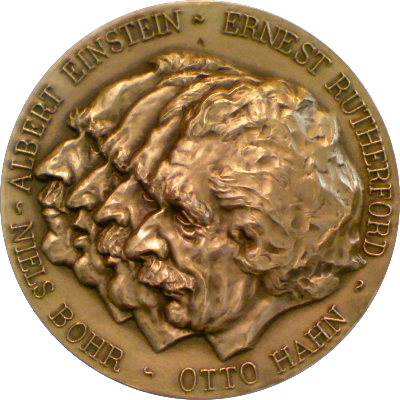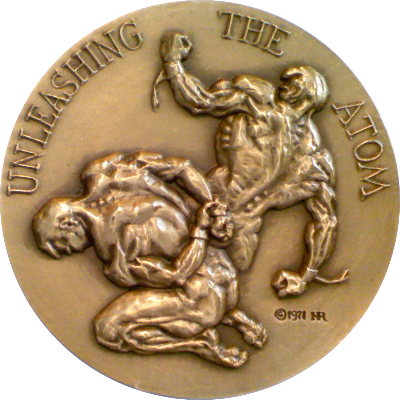Artist Name
You can click medals to switch between obverse and reverse sides.
-
Unleashing the Atom 1971by Hal Reed

 SOM-83.1Golden bronze with tan patina
SOM-83.1Golden bronze with tan patinaThis medal was chosen as the 83rd issue of the prestigious Society of Medalists series in 1971.
The obverse bears four rugged conjoined portraits l. Around, ALBERT EINSTEIN - ERNEST RUTHERFORD - / -NIELS BOHR - OTTO HAHN
The reverse bears two muscular figures, one shackled, the other broken free. Above, UNLEASHING THE ATOM; at lower right, © 1971 (HR monogram)
The four scientists that Reed chose to represent nuclear energy were among the finest physicists dealing with sub-atomic matters: Einstein developed the Theory of General Relativity, one of the two pillars of modern physics; Rutherford is sometimes called the Father of Nuclear Physics because he discovered that most of an atom's mass is located in its nucleus, thereby providing evidence that sub-atomic nuclear structures existed; Bohr introduced the idea that waves and particles were two sides of the same medal (pun intended) and developed quantum theory; Hahn is one of the dicoverers of nuclear fission.
The 1970's were a time when energy crises threatened to shatter Americans' comfortable lives. In 1970 American petroleum production had peaked and a run-up of prices followed. Nuclear energy, a virtually unlimited source of energy that could be created from materials at hand, seemed the solution.
As Hal Reed wrote in his "From the Artist":
"Man has sought sources of energy from the beginning of time in fire, steam, water, oil. Now he has tapped an almost unlimited source of energy, the fundamental source that powers the universe."
Mankind's opinion of nuclear energy became much less optimistic over time as Tchernobyl and Fukushima highlighted practical problems in dealing with a force that powers the universe.
This medal measures 73mm in diameter and was struck by the Medallic Art Company of New York. The reported production quantity of this medal is 1,310 in bronze and 1 in silver.
SOM-83.1Bronze73.0mm (2.87in)Red-gold bronze with tan patinaTHE SOCIETY OF MEDALISTS 83RD ISSUE - MAY 1971 HAL REED, SC.(C)MEDALLIC ART CO.N.Y. BRONZESOM-83.2Silver73.0mm (2.87in)THE SOCIETY OF MEDALISTS 83RD ISSUE - MAY 1971 HAL REED, SC.(C)
Contact me if you have links that might merit inclusion on this page.
Books & Articles
Research Archives and Websites
Museums